In this post I have had a go at using firecalc to help with modelling appropriate levels of spending during my Retirement. In order to follow this post, you will need to read the “Retirement Calculations” post as this describes my financial position and provides background on the information I am entering into firecalc.
For firecalc I started from age 60 rather than 52, because the assets before 60 are in cash and not easily modeled. I put in the value of Super at 60 arising from my standard model into the firecalc “Start Here” portfolio value, a “Years” value of 30 (from 60 to 90) and also put in the value of my house in the Portfolio section to be added in 2019. I also tried to model the age pension by putting in a social security payment of $15,000 per year starting from when the age pension cuts in (about 74). This is overstating the age pension in the early post 74 years, and understating it later on. Lastly, I only looked at historical years from 1923 (the same historical period in my original blog).
Firecalc offers the following types of spending patterns:
- A fixed spending amount (adjusted for inflation).
- “Bernicke’s Reality Retirement Plan”, whereby spending is reduced by 2-3% every year from 56 until you reach 76.
- A spending plan whereby you adjust your spending depending on the value of your portfolio each year, spending the same percentage of your remaining portfolio in future years as you are spending the first year.
The third option doesn’t really work in my case, as I have assets coming in after the first year.
Bernicke’s Reality Retirement Plan
In the second option you have to manually work out the best value of “Spending” in the “Start Here” section. The best value for me seems to be about $120,000:
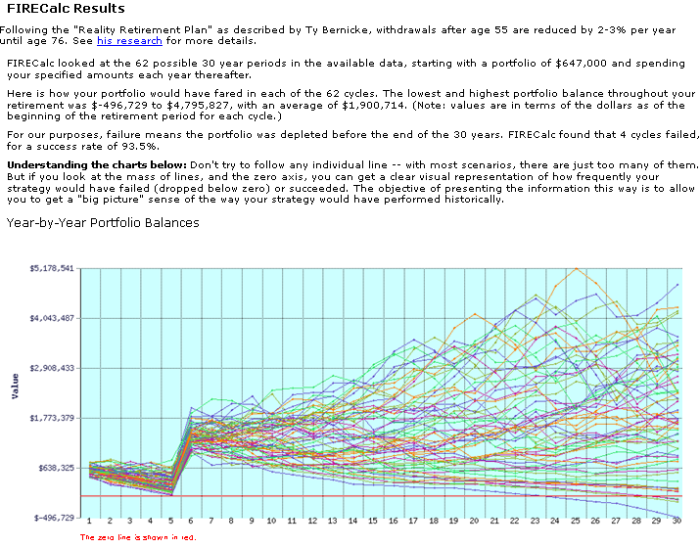
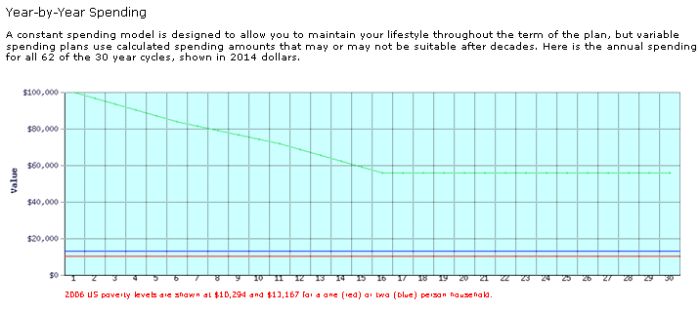 This is suggesting I start spending $105,000 per year (including rent) at 60, declining to about $63,000 from 75 onwards.
This is suggesting I start spending $105,000 per year (including rent) at 60, declining to about $63,000 from 75 onwards.
If I put in a 3% drop in spending per year between 56 and 76 in my model, to have it make sense I need to work for an additional 2 years (because otherwise I have an increase in spend per year when I hit 60 due to the limited assets prior to 60). To aid in the comparison, I get the diagram below:
This is suggesting I start spending up big at 56, and then finish up at just under $80K at 76. I think Bernicke might have something here as this looks like a good spending model!
Fixed Spending Model
For Option 1 (the fixed spend per year), firecalc can work to suggest a value of spending to use here. To get 95% of historic years with a positive balance after 30 years, firecalc tells me an appropriate level of spending is about $69K ($74K with rent).
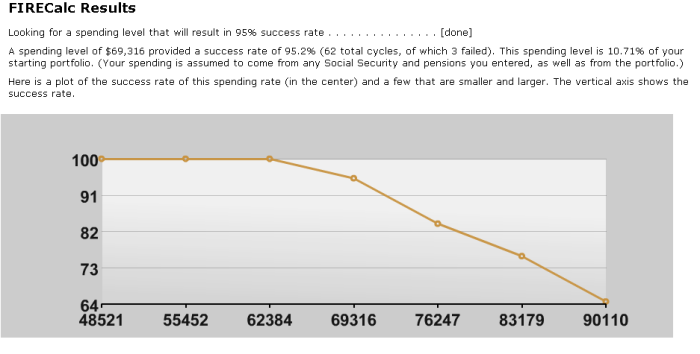 The diagram below shows the value of the Portfolio with this fixed spending value. Note that in most years it is quite large, but in a small number it goes negative.
The diagram below shows the value of the Portfolio with this fixed spending value. Note that in most years it is quite large, but in a small number it goes negative.
I can do similar firecalc type calculations using the market data that I have collected. It’s interesting to see how the following compare:
- The maximum spend that will result in more than 95% of passes (i.e. not running out of money after 30 years) using the firecalc site calculations versus the same figure using my firecalc type calculations. Any differences should be indicative of the differences between US and Australian markets.
- The maximum spend that will in result in more than 95% of passes using my firecalc type calculations versus the average spend resulting from my original historic calculations.
The graph below shows the percentage of passes (i.e. the number of years in which I do not run out of money after 30 years, given a historic start year) using my firecalc type calculations. There are two lines on the graph:
- One only considering starting from years between 1923 and 1981, the years for which I have complete market data for the start year and for the next 30 years. When using the firecalc site, I have used a similar range (1923 to 1983).
- One considering starting from years between 1923 and 2011, with years past 2012 using standard 5.5/6.0% market returns. I have used these years to calculate the average historic spend in my original historic calculations.
To get more than a 95% pass rate using start dates to 1981, my firecalc type calculations indicate the most I can spend is about $74K. The firecalc site also comes up with $74K. Note that Firecalc site is using US markets, while my firecalc type calculations are using Australian markets. According to this article, returns on both markets are very similar:
http://cuffelinks.com.au/wins-australian-versus-us-investors-local-shares/
To get more that a 95% pass rate using start dates between 1923 and 2011, my firecalc type calculations indicate the most I can spend is about $76K. The average spend that would result from retiring over this time period and moderating spending patterns each year, as described in the original post, is $105K, quite a difference! The reason for the difference is that in the original post spending is moderated, rather than using a fixed spend each year. So, when Super performs well spending is increased, and when it performs poorly, spending is reduced. In the original post for each historic retirement year you always end up with zero assets at age 90, rather than the often large unspent portfolios as per firecalc.
Thoughts about Firecalc and spending Patterns
The problem with the firecalc approach is that you will often end up with large unspent portfolios. In an effort to avoid the possibility of running out of money, the indication of how much you can spend each year is understated. I prefer the model in my original post whereby you work out how much you have to spend each year based on the value of your present portfolio, with the aim of minimizing the funds on your last year while keeping your spending equal in real terms except where there is a change in the availability of financial assets due to asset sales, eligibility to access funds based on age, or a conscious choice on change in spending pattern..
Using this approach, retirement during any particular historical year never results in running out of money because you are moderating your spending behavior each year, based on how your Super performs. The result of the approach is a graph of average spending per historical retirement year, which should provide a good indication of spending levels in your actual retirement. To make things clearer, a graph of the distribution of average spend over the historical retirement years can also be produced.
The approach in the original post can also recommend spending levels each year once you are in your retirement based on Super performance the previous year.
So, for example, if I apply this to my situation, the minimum average spend I would have experienced if I retired over 90 historical time periods is about $83K, the average is about $105K and the maximum is about $148K – so I can reasonably expect about $100K per year average spend. Furthermore, I can use the model to let me know the recommended levels of spending each year as I progress through my retirement and as actual Super return information becomes available. How this works is explained in the “Planned Versus Actuals” post.
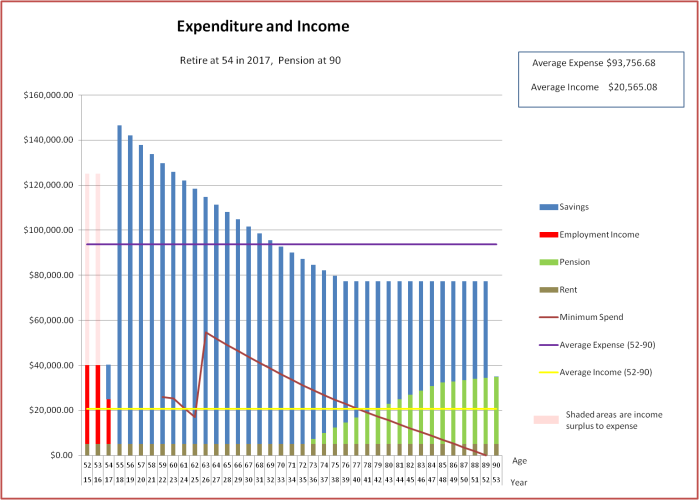
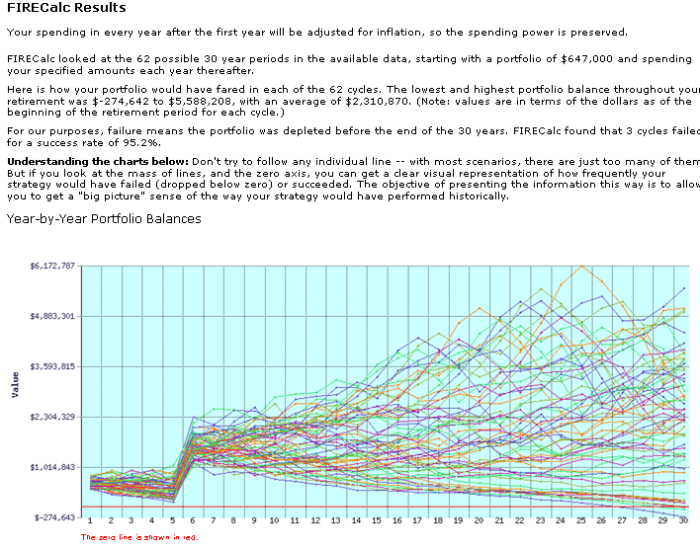
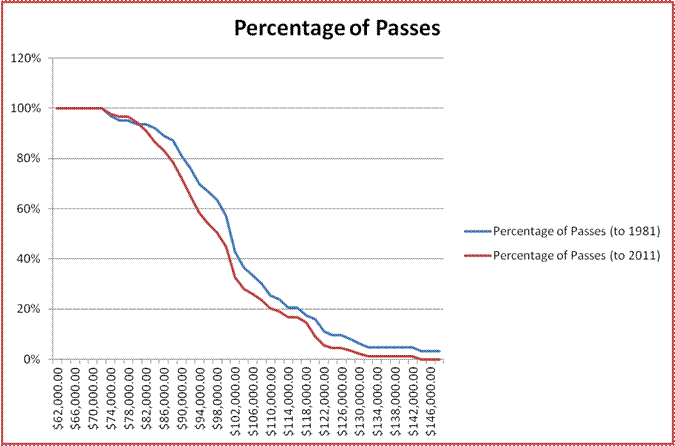
Thanks for a excellent blog that analyses retirement finances from an Australian perspective. There’s plenty of USA blogs out there but of course their retirement funding system and financial legislation is quite different and often not applicable (apart from the broad concepts)
We retired a year ago at ages 63 and 61 – hardly early retirement but we were relatively modest income earners in the not-for-profit sector although in professional jobs that we enjoyed.
Our lifestyle doesn’t need a high income, we love bushwalking and bike riding BUT we do spend a fair bit on overseas travel although it is lower budget, off the tourist trail stuff. I’ve estimated 65K per annum will be sufficient.
I’ll run our figures through the various modelling and see how we look. Some of the background stats are a too in-depth for me, although I’m probably a bit lazy as I studied a fair bit of statistical analysis in my uni student days (decades ago).
LikeLike